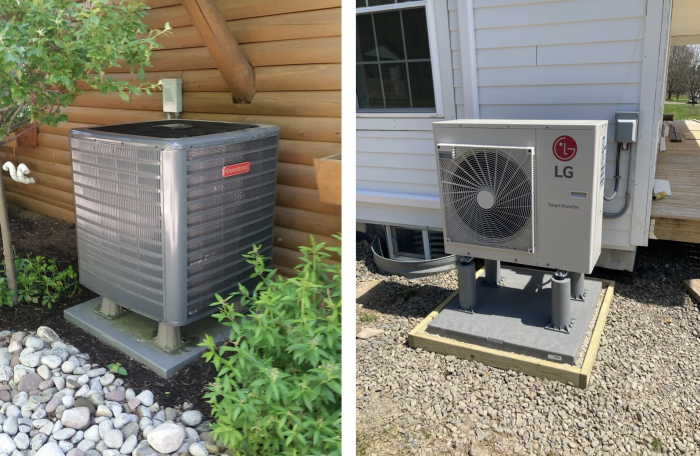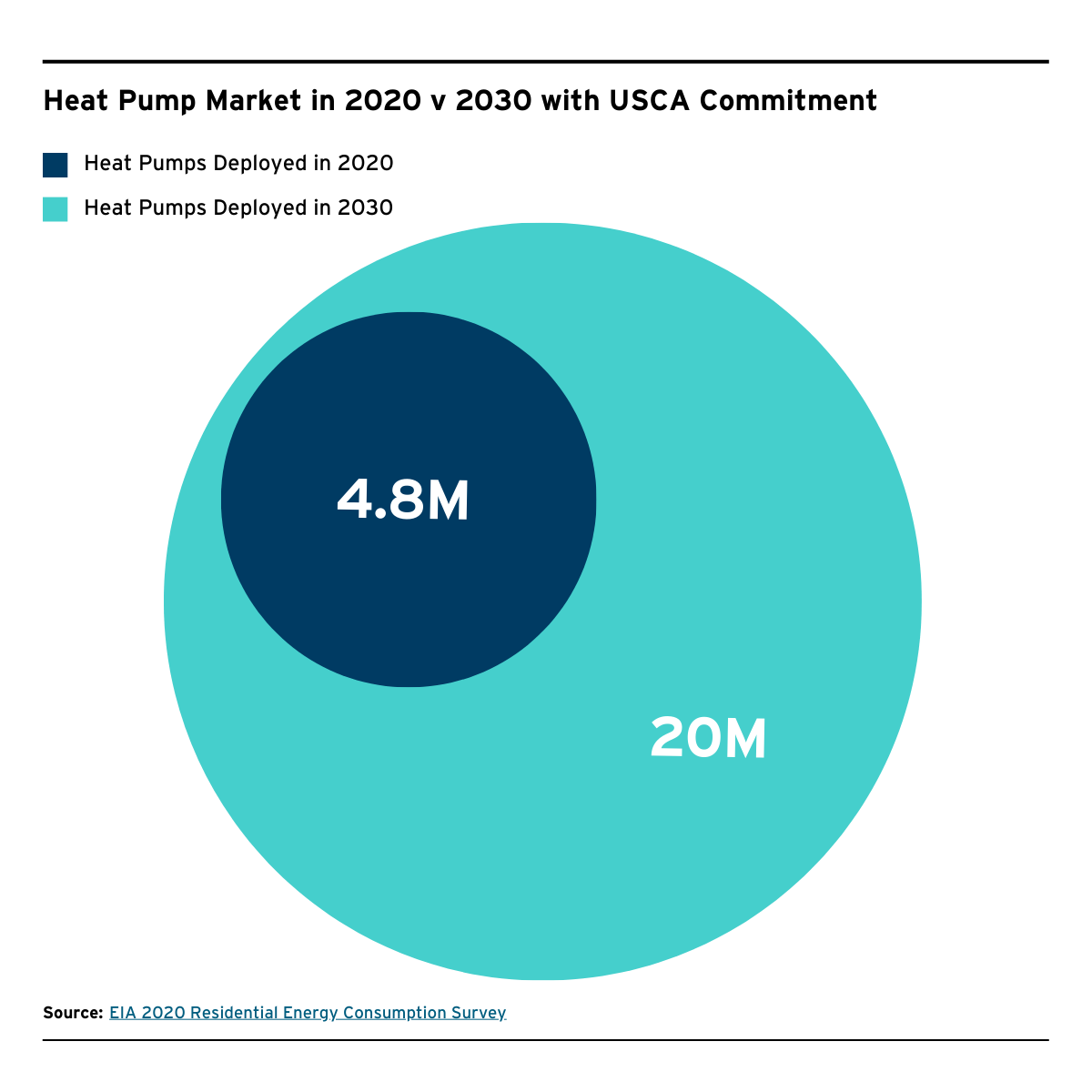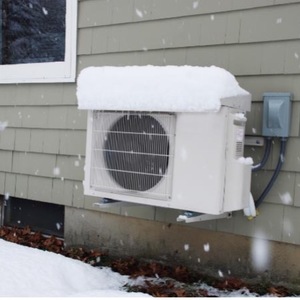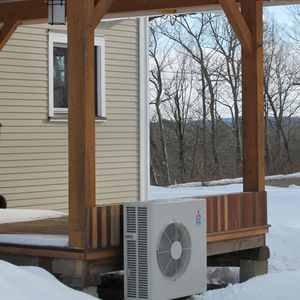
Today, a consortium of U.S. states and territories representing more than half of the U.S. economy announced a commitment to collectively reach 20 million residential electric heat pump installations by 2030. At least 40 percent of benefits flow to disadvantaged communities. This new target from the bipartisan coalition of 25 governors known as the U.S. Climate Alliance was announced alongside a series of multi-state policy goals and commitments to eliminate building emissions. This commitment demonstrates the widespread support for building electrification across the country.
Why it matters

Heat pumps and heat pump water heaters are core decarbonization technologies that allow buildings to switch from burning fossil fuels for heating and hot water to using electricity instead. Making this switch can reduce home heating emissions in every U.S. state by 35–93 percent while saving lives through improved air quality and protecting residents from volatile gas commodity prices.
Meeting the goal set by these governors would quadruple the number of residential heat pumps and heat pump water heaters operating in these states between 2020 and 2030, bringing the states within reach of the deployment needed to hit U.S. climate targets. It would also drive the creation of good-paying jobs while advancing equity for low-income families and communities of color that bear a disproportionate cost and energy burden.
With this new commitment and sustained leadership by the Biden administration, communities across the United States are poised to take part in an international movement toward fossil-free homes and workplaces: the EU has targeted 30 million new heat pump installations in this decade, and countries covering over 70 percent of global heating demand now offer incentives for heat pumps.
Pathways to accelerate heat pump adoption
A combination of economics and policy will drive heat pump installations. Many heat pumps will go where they are already cost-effective without incentives while others will follow paths carved by funding from the Inflation Reduction Act (IRA) and state policy. We can expect to see the most progress in these sectors:
Low-income households
Before the IRA, heat pumps and other electrification upgrades were unreachable for many low-income households, which often cannot tap the financing and incentives available to middle- and upper-income households. With new rebates of up to $8000 for heat pumps and $6500 for panel upgrades and wiring, the IRA and complementary state or utility incentives open the door for low-income homes to be more efficient, resilient, and comfortable. The governors’ commitment to prioritize heat pump deployment in disadvantaged communities in line with Justice40 Initiative principles helps to ensure these states will take additional steps toward equitable access.
New homes
Building all-electric new homes with heat pumps is less expensive than building a mixed-fuel (gas and electric) home. The economic case gets even stronger with IRA incentives offering up to $5000 for homes constructed to the Zero Energy Ready Home standard. The policies for capturing this opportunity are already established in three states (New York, Washington, and California) and over 100 jurisdictions that require or strongly encourage developers to build all-electric.
Electric resistance and delivered fuel systems
Roughly 20 million homes rely on electric resistance heaters and 10 million use delivered fuels (fuel oil and propane) for heating. These systems are expensive to operate and found disproportionately in low- and moderate-income households. An equitable transition that replaces electric resistance and delivered fuel-powered heating with heat pumps can save residents an average of $2100 and $1700 in annual energy costs, respectively.
Air conditioning system replacements
Heat pumps are essentially efficient air conditioning units that can run in reverse to also provide heat. Encouraging homeowners to swap in heat pumps when their existing air conditioner dies overcomes many hurdles: it taps an existing workforce of AC contractors; electrical capacity is less likely to be an issue with central AC; and it avoids “emergency” installation in the dead of winter.
Homes with solar
Solar-powered homes see improved returns for heat pump conversions because solar often generates cheaper electricity than the grid provides. Heat pumps, in turn, can improve the economics of residential solar installations by providing increased load for larger, more cost-effective solar systems. With new IRA incentives covering 30 to 70 percent of solar system costs, there has never been a better time to bundle these two clean energy measures.
What happens next is crucial
The leadership demonstrated by U.S. Climate Alliance governors combined with the many market opportunities for heat pumps today is encouraging. For the states to reach their heat pump commitments in a timely and equitable manner, however, they will also need to develop complementary building decarbonization policies.
The most immediate step is for states to leverage new federal IRA funding to help low- and moderate-income homes upgrade and electrify. States can act now to implement the U.S. Department of Energy’s flagship Home Energy Rebate programs to provide significant funds to low-income households. Pairing these rebates with other federal, state, local, and utility incentives can help deliver whole-home retrofits and more resilient neighborhoods. New incentive programs will have greater impact and contractor uptake if they are made accessible through universal applications, streamlined reporting, timely payments, and public awareness—underscoring the importance of today’s commitment to streamline incentives and educate consumers.
Beyond leveraging IRA funding, states should take complementary steps to ensure electrification is affordable to the most marginalized and lowest-income communities. This includes unlocking new state and utility funding, scaling successful low-income electrification pilots into statewide programs, establishing inclusive financing programs, rate reform, and low-income bill and tenant protections.
Lastly, regulations must align utilities, manufacturers, builders, and contractors around decarbonization. Strong models exist for these regulations, including building codes, appliance pollution standards, and clean heat standards. RMI’s building electrification factsheets provide a resource for state policymakers and advocates as they advance this critical work.
Weekly Newsletter
Get building science and energy efficiency advice, plus special offers, in your inbox.














4 Comments
Heat pumps are great but it would be interesting if this article also talked about how they're going to generate enough electricity to power all those heat pumps. You can only dam so many rivers and if you're just burning fossil fuels to produce that electricity, then are we really doing that much better? There's been some talk of nuclear power making a comeback. It might be the only way to generate enough electricity without the high carbon emissions associated with burning fossil fuels. I would be interested to hear other people's thoughts on this.
It’s an easy calculation to show that burning natural gas to power a heat pump is cleaner than burning it directly in a furnace. And the grid is much cleaner than 100% gas.
There is currently an accelerating build out of renewable electricity generation capacity in the US, led by wind and solar. Last I checked, at current build pace, all new electricity load growth was being met by new renewable additions, or thereabouts.
So we are not yet at the point of renewables displacing existing fossil fuel electricity generation, but each new EV or heat pump that is adding to electric load today is being matched by new renewable electricity generation.
Load growth in the grid in my region (ISO-New England) where heat pump adoption is low, but being pushed higher by state policies, is forecast to grow about 2% per year. It's definitely a change from zero-load growth over the last 20 years, but isn't anything crazy impossible to meet.
There will be plenty of hiccups while building a whole lot of big new stuff, but this is not a insurmountable hurdle.
RMI, the author of this article, also does lots of research on decarbonizing electric grids - check their work out on their website.
Heat pump programs should replace resistive baseboard electric and water heater.
There's plenty of homes still using baseboard electric in the rural US. I occasionally search for sale listings just to pass time and many homes >50 years old still have the old baseboard heaters. I live in IECC Zone 6, so during winter it's a large heating load. When I lived in the Southern US, baseboard heaters were there too. These high COP heat pumps mean the load for these homes will go down.
Add in electric water heaters to this, which I also find in service despite being >15 years old. Those should be replaced with HPWH to lower their electric demand.
Log in or create an account to post a comment.
Sign up Log in